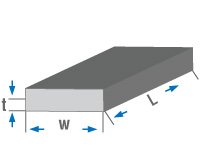Sheet Metal Plate Weight Calculation
Calculating the weight of sheet plates — whether black sheet, sheet plate weight, or any sheet calculation you need — is based on multiplying the relevant dimensions by the metal's specific gravity using the weight calculation tool. Yakup Yılmaz Boru's sheet weight calculation page allows you to quickly and accurately calculate the weight of any sheet.
How to Calculate Sheet Weight?
Calculating sheet weight is very important to procure the right amount of material and to plan your budget accurately. Below, we explain step by step how to calculate sheet weight.
1. Sheet Weight Calculation Formula
The basic formula for calculating sheet weight is as follows:
Weight (kg) = Length (m) x Width (m) x Thickness (mm) x Density (kg/m³)
Here, density (specific gravity) varies depending on the type of material used. For example:
- For steel, the density is generally taken as 7.85 g/cm³ (7,850 kg/m³).
- For aluminum, the density is known as 2.7 g/cm³ (2,700 kg/m³).
2. Determine Dimensions
Measure the length, width, and thickness of the sheet, or find the correct values from a technical document. Make sure your measurements are in meters and millimeters.
Example:
- Length = 2 meters
- Width = 1 meter
- Thickness = 2 mm
3. Determine the Material's Density
Identify the type of material and find its corresponding density value. For example, if the sheet is made of steel, you can take its density as mentioned above, 7,850 kg/m³.
4. Apply the Formula
Let's calculate the weight of an example sheet:
- Length: 2 m
- Width: 1 m
- Thickness: 2 mm = 0.002 m (convert millimeters to meters)
- Density: 7,850 kg/m³
Weight = 2 x 1 x 0.002 x 7,850 = 31.4 kg
In this case, the total weight of your sheet will be 31.4 kg.
5. Practical Calculation Tips
- Using a Calculation Table: You can create a ready table containing density values and standard sheet dimensions, or use the pages provided on our site: Galvanized Corrugated Sheet Weights.
- Double-Check Your Estimates: Verify your measurements once again to avoid mistakes.
- Different Materials: If you are using a material other than steel, be sure to refer to the density table below according to the type of material.
6. Importance in Planning and Purchasing Decisions
The weight you calculate impacts many factors, from transportation costs to the load capacity of structures. Accurate calculation helps prevent extra costs and allows you to clearly define your needs.
Sheet Plate Weight Calculation
The online calculator on our website allows users to easily input all relevant parameters such as material thickness, length, width, and other dimensions of the sheet plate to obtain instant results.
Material Weight Calculation
Pipe weight calculation, box profile weight calculation, profile weight calculation, angle iron weight calculation, flat bar weight calculation, sheet weight calculation—you can find various metal material weight calculations at Yakup Yılmaz Boru. Material weight calculation is now easier than ever.
Metal Weight Calculation
Various formulas are used for metal weight calculation. First, we need to determine the volume and quality of the metal piece we want to calculate the weight of. For volume measurements, standard measurement units should be used. For example, you can calculate the weight in grams or kilograms for a metal piece whose volume is measured in millimeters.
Specific Gravity Table
| Symbol | Material | Density (g/cm³) |
|---|---|---|
| Al | Aluminum | 2.7 |
| Sb | Antimony | 6.69 |
| Cu | Copper | 8.9 |
| B | Boron | 2.33 |
| Zn | Zinc | 7.13 |
| Fe | Iron | 7.87 |
| Sn | Tin | 7.29 |
| C | Carbon | 2.2 |
| Co | Cobalt | 8.9 |
| Cr | Chromium | 7.2 |
| Pb | Lead | 11.34 |
| S | Sulfur | 2.07 |
| Mg | Magnesium | 1.74 |
| Mn | Manganese | 7.43 |
Metal weight calculations can be simplified by using various formulas. By applying these formulas, you can accurately calculate metal material weights based on the relationship between the volume and weight of the metal piece.
To determine the quality of a metal piece, four basic types of analysis should be considered: Density (g/cm³), hardness (HB), elasticity (open/bent bridge test), and strength (N/mm²). Each of these analyses can be used to determine the physical properties of metal pieces.
Density is the most important indicator used to calculate the efficiency of a metal piece's weight. Density is the volume-to-weight ratio based on the volume of the metal piece. By considering the density values of materials, you can easily use the weight calculation page on our website to perform pipe, sheet, box profile, flat bar, and sheet weight calculations.
The hardness value indicates the amount of indentation or applied stress on metal pieces. The hardness of metal pieces is used in material calculations on the Yakup Yılmaz Boru website by considering many available hardness values.
The elasticity value shows the deformation of metal pieces under applied load. The elasticity of metal pieces is included in calculations by utilizing the results from open/bent bridge tests available on the site.
Finally, the strength value indicates the capacity of metal pieces to withstand applied tensile force. On the Yakup Yılmaz Boru website, this value is measured in N/mm² and can be reviewed, for example, on the angle iron technical tables page.
Any type of metal can be used, including iron, aluminum, steel, or copper. Yakup Yılmaz Boru also offers many calculation options for pipe weights (including curved pipes), box profile weight calculations (you only need two side widths), as well as for angles and flat bars.












